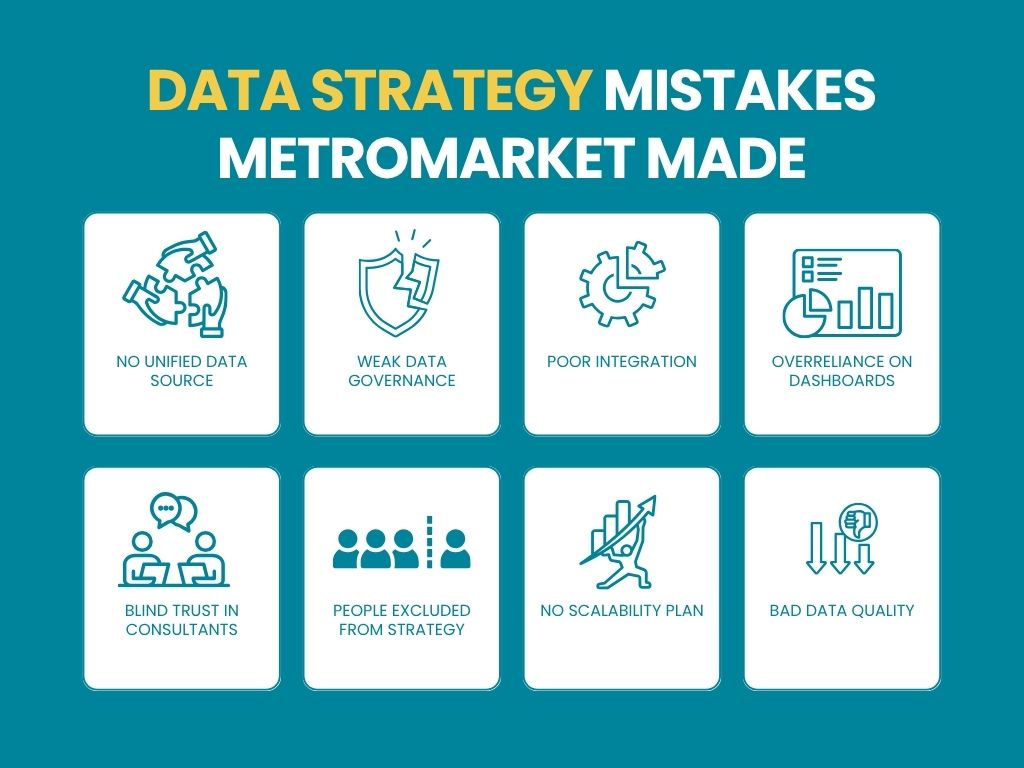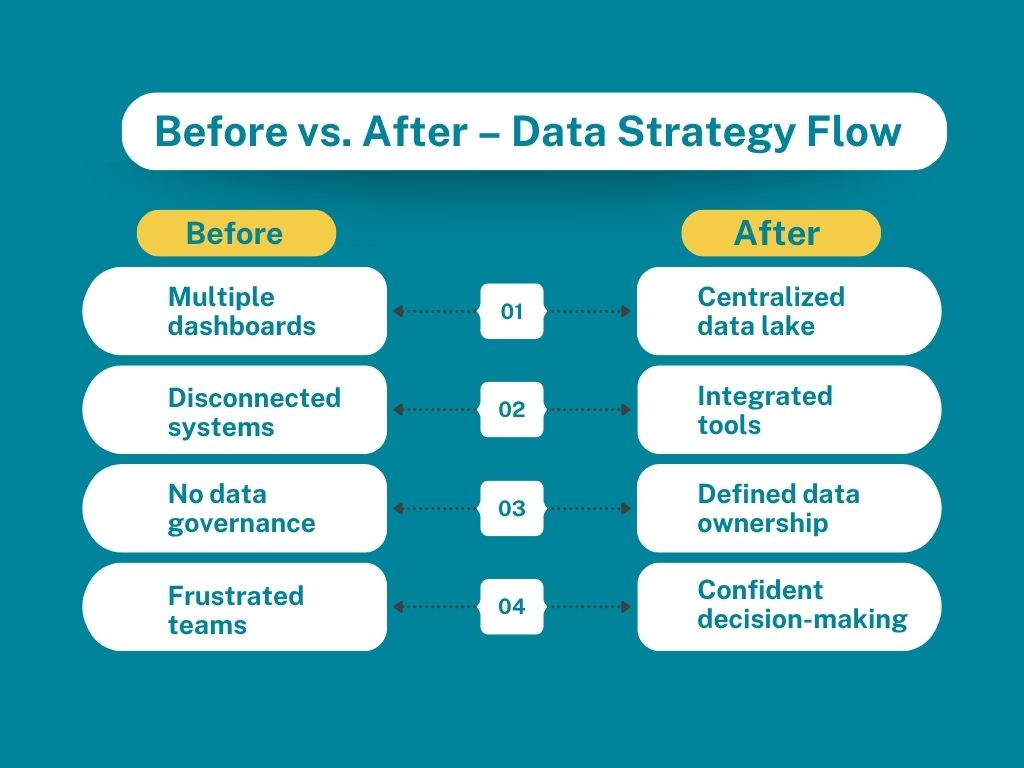In a world where data drives decisions, having a solid data strategy isn’t just important—it’s essential. Yet, manyf businesses, both big and small, fall into common traps that undermine their ability to use data effectively. From siloed teams and broken integrations to poor governance and low data quality, these missteps can quietly erode trust, accuracy, and performance.
This article explores a real world case “MetroMarket”—to illustrate how even promising companies can falter without a strong data foundation. More importantly, it offers practical solutions to help your business avoid the same fate.
The Cautionary Tale of MetroMarket
MetroMarket was once a rising star in the world of online grocery platforms. With its promise of hyper-local delivery logistics, it gained traction quickly—earning investor support and a loyal user base within two years. It looked like a success story in the making.
But beneath the surface, critical cracks were forming. By mid-2024, complaints about late deliveries, inconsistent service, and poor customer support began to pile up. The root cause? A series of overlooked data strategy mistakes that gradually weakened the very foundation of their operations.
This blog walks you through what went wrong at MetroMarket and how your business can avoid making the same costly errors.
Mistake #1: No Unified Data Source
MetroMarket’s departments—marketing, sales, logistics, support—each had their own data systems and dashboards. Without a centralized source of truth, these decentralized data teams made decisions in isolation.
Real-World Impact: The marketing team promoted products that were out of stock. Customer support couldn’t provide accurate delivery updates. Everyone was working hard but off different pages.
Lesson: Data silos don’t just slow down operations; they lead to bad customer experiences.
Fix It: Consolidate your data into a central repository and ensure real-time sync across systems. This makes data accessible, reliable, and consistent company-wide.
Mistake #2: Weak Data Governance
In their rapid expansion, MetroMarket skipped over the basics of data governance best practices—things like data validation, naming conventions, and ownership protocols.
Real-World Impact: Duplicate customer profiles. Wrong delivery addresses. Conflicting KPI reports. When leaders can’t trust their numbers, they can’t lead effectively.
Tip: Don’t let governance be an afterthought. It’s the rulebook that keeps your data clean and trusted.
Fix It: Assign data stewards, set up rules for data handling, and audit regularly to prevent future errors.
Mistake #3: Poor Integration Across Systems
MetroMarket’s architecture wasn’t ready for multi-channel integration. As they added new tools—delivery partners, loyalty apps, kiosks—their systems struggled to communicate.
Real-World Impact: Customers saw outdated prices and inaccurate delivery windows. Internally, teams spent hours reconciling reports from different platforms.
Truth: Integration isn’t plug-and-play. It’s a process that requires long-term planning.
Fix It: Use scalable middleware or integration platforms that ensure clean, consistent, real-time data flows.
Mistake #4: Overreliance on Dashboards
Having a dashboard is great. But relying on it without context or training? That’s dangerous.
Real-World Impact: A drop in app usage triggered a budget cut for marketing—when the real issue was a back-end server failure. This led to more damage and confusion.
Tip: Numbers don’t speak for themselves. Your team needs to know how to read and act on them.
Fix It: Invest in data literacy. Hold workshops. Label and annotate dashboards to explain what each number actually means.
Mistake #5: Letting Bad Data Slide
MetroMarket underestimated how much data quality issues can cost. No one was actively validating customer data, product listings, or pricing updates.
Real-World Impact: One pricing error cost the company over $100,000 in a single day. Wrong SKUs caused missed deliveries and customer churn.
Lesson: Bad data creates bad outcomes, and it’s usually expensive.
Fix It: Run routine quality checks. Automate alerts for anomalies. Make someone accountable for cleaning and managing the data.
Mistake #6: No Scalability Plan
Everything worked fine when MetroMarket operated in one city. But scaling to five regions broke their infrastructure.
Real-World Impact: Reporting tools timed out. Delivery routes clashed. API calls exceeded usage limits. The system simply couldn’t keep up.
Warning: Don’t build for today; build for where your business will be next year.
Fix It: Migrate to cloud-native tools. Use autoscaling services. Monitor system loads and plan upgrades in advance.
Mistake #7: Forgetting People Matter
MetroMarket hired great data scientists but didn’t bring the rest of the team along for the journey. Frontline employees didn’t understand or trust the new data tools.
Real-World Impact: Staff ignored dashboards, fell back on gut decisions, and resisted adopting insights suggested by analysts.
Human Truth: Even the best strategy fails without buy-in.
Fix It: Involve every department in your data strategy. Highlight success stories. Celebrate when a data-driven decision leads to real results.
Mistake #8: Blind Trust in Consultants
When things went south, MetroMarket hired high-end consultants hoping for a quick turnaround. But without understanding company culture or limitations, the consultants gave generic advice.
Real-World Impact: The proposed solution was too complex, too expensive, and impossible to implement on time.
Reminder: You can’t outsource responsibility.
Fix It: Choose consultants who collaborate with your internal team. Look for actionable roadmaps, not just PowerPoint slides.
Why Do Most Data Strategies Fail?
MetroMarket isn’t alone. Many businesses, from tech startups to established enterprises, struggle with data strategy implementation. The reasons are surprisingly consistent—and preventable.
- Lack of Business Alignment: Often, data strategies are built in a vacuum, driven by IT or analytics teams without fully understanding what the business actually needs. Without aligning the strategy to tangible goals like improving customer retention or streamlining operations, the data becomes irrelevant.
- Weak Governance Structures: Companies frequently underestimate the importance of governance. Without policies that define data ownership, standardization, and access, chaos quickly follows. This leads to inconsistent data quality, compliance issues, and decision paralysis.
- Tools Without Enablement: Buying a powerful tool doesn’t mean people know how to use it. Many organizations implement new dashboards or platforms but fail to train their teams, resulting in underused assets and misinterpreted insights.
- No Accountability: When everyone owns the data, no one does. Many data strategies collapse because there’s no clear accountability. KPIs aren’t tracked properly, and decisions lack ownership and follow-through.
- Short-Term Thinking: Businesses often rush to solve immediate problems—like a failed campaign or underperforming channel—without investing in long-term strategy. Quick fixes may provide momentary relief, but they rarely create lasting value.
The good news? All of these challenges can be overcome. With clear ownership, ongoing education, a long-term vision, and alignment between data teams and business goals, companies can turn their data into a competitive advantage instead of a liability.
A Quick Self-Check for Your Business
Before diving deeper into new tools or restructuring teams, take a moment to reflect on how your current data strategy is performing. Honest answers to these simple questions can reveal critical gaps in your system:
- Is your data unified and accessible across teams? Or are departments still working in silos, each with different numbers and definitions?
- Are your reports accurate and trusted by leadership? Or do decision-makers second-guess the insights they’re given?
- Is your system prepared to grow with your business? Or does it already feel strained under current demand?
- Are all teams trained in using and understanding data? Or is data literacy limited to just a few analysts?
- Can your current tools integrate seamlessly? Or do you rely on manual exports, copy-pasting, and disconnected platforms?
If even one answer made you pause, it may be time to rethink your approach. A healthy data strategy should feel aligned, scalable, and empowering across the organization—not confusing or reactive.
Final Thoughts
Data should power your business, not paralyze it. MetroMarket’s story is a reminder that good intentions aren’t enough. Without structure, accountability, and a people-first approach, even the best ideas can collapse.
Want help designing a strategy that actually works? Let’s talk. Our team can help you turn messy data into meaningful action and avoid the mistakes that took down MetroMarket.
Frequently Asked Questions
1. What are the most common data strategy mistakes businesses make?
Some of the most common issues include siloed data teams, poor integration between platforms, lack of data governance, and failing to align the strategy with business goals.
2. How do data silos hurt business performance?
Data silos prevent teams from seeing the full picture, which can lead to duplicated efforts, misaligned strategies, and poor customer experiences due to inconsistent or outdated information.
3. What does good data governance look like?
Strong data governance involves clear data ownership, standardized procedures, regular quality checks, access control, and compliance with data regulations. It ensures data is clean, secure, and trusted.
4. Can small businesses benefit from a data strategy?
Absolutely. Even small businesses generate valuable data. A clear data strategy can help streamline operations, identify opportunities, and improve customer relationships—without needing a big data team.
5. What’s the first step to fixing a broken data strategy?
Start with an honest audit. Evaluate where your data lives, who uses it, how it’s managed, and how decisions are made from it. From there, align your data goals with your business priorities and build a phased improvement plan.









